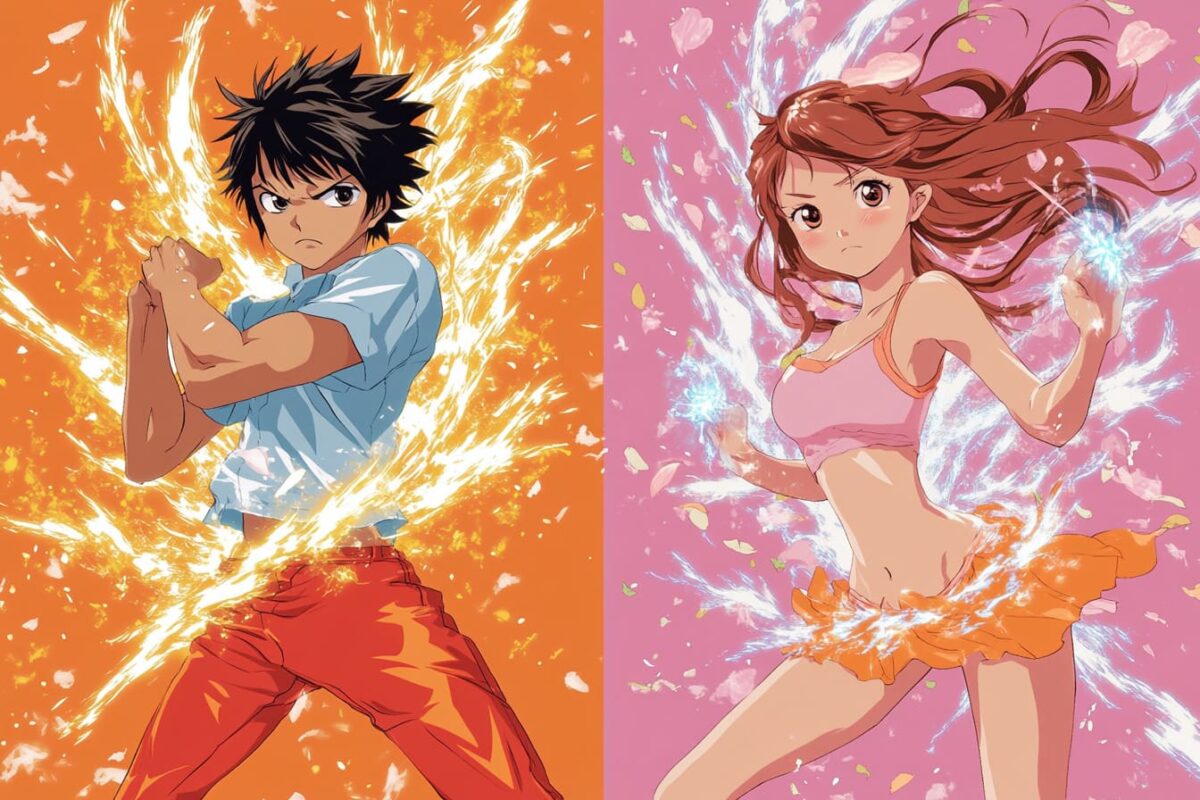Let’s be honest: you can usually tell within five seconds whether you’re watching a shonen or a shojo anime—just by looking at the hair.
If the main character has gravity-defying spikes and an urgent need to scream the name of his next attack, congrats: you’re deep in shonen territory. But if the screen fills with sparkling eyes, floating flower petals, and enough emotional weight to trigger a slow-motion teardrop, welcome to the world of shojo.
These two art styles are more than just genre staples. They’re visual dialects. Cultural codes. Entire aesthetics wrapped in linework, palette choices, and dramatic zoom-ins. So let’s dig into the delicious contrast between the bold punch of shonen and the sparkly swoon of shojo, and why they both serve—just in radically different ways.
Designed by Demographic, Styled for Drama
Let’s spill some matcha: shonen anime is aimed at boys and teen guys. Think Dragon Ball Z, Naruto, One Piece. You know, the holy trinity of explosive action, impossible hair physics, and emotional power-ups yelled at full volume.
Shojo, on the other hand, caters to girls and young women with a flair for romance, friendship, and yes, the occasional heartbreak under a cherry blossom tree.
But while these styles grew from audience targeting, their artistic legacies go way deeper.
Shonen: All Action, No Subtlety (and We Love That)
A typical shonen hero doesn’t walk into frame—he explodes into it. The art style backs this up with high-saturation colors, sharp lines, and bold silhouettes. Hair is a personality trait. Fists are storytelling devices. And everything is urgent.
Need a visual? Just watch Goku go Super Saiyan or Luffy stretch-punch his way through villains. Their entire design language screams “I’m here to save the world, or at least win the tournament.”
Even the backgrounds are in on it—speed lines fly, the ground cracks dramatically, and don’t even get me started on the glow-ups. This style is all about kinetic energy and making every punch feel like a meteor hit.
Shojo: Pretty, Poetic, and Packed with Emotion
Now enter the shojo realm: where eyeliner is impeccable, gazes are meaningful, and someone is probably holding a school bag with just one hand because it’s ✨aesthetic✨.
Shojo art leans hard into expressiveness and elegance. The eyes are big enough to contain entire emotional arcs. The hair flows like a Pantene commercial in zero gravity. And background sparkles? They’re not optional—they’re mandatory.
Just peek at a scene from Ouran High School Host Club. A single rose petal drifting through the air tells you everything you need to know about the drama, the romance, and whether or not the main character is about to trip into someone’s arms.
The tone may be soft, but shojo visuals are laser-focused on capturing emotional high notes. And when things get serious? Cue the close-up, the tear, and the suddenly symbolic wind.

Drama in the Details
Shonen throws its punches in bold strokes. Shojo whispers them through glances and glows. But both styles are obsessed with detail—just different kinds.
In shonen, details highlight power: muscle definition, impact debris, aura flares. It’s all about showing off strength, motion, and pure, unapologetic intensity.
In shojo, the details live in fashion, posture, and emotional cues. A blush is a plot device. A sideways glance can kill. Sparkles and flower overlays aren’t just pretty—they’re visual metaphors for feelings.
Want proof? Just rewatch Cardcaptor Sakura’s transformation sequences. Every frill, every wand spin, every fluttering ribbon is a whole vibe—and it’s saying, “I feel things deeply, and I’m going to look fabulous while doing it.”
Humor, Handled Differently
Even the way these genres do comedy reflects their stylistic differences.
In shonen, expect big slapstick moments: a character gets hit with a frying pan, and the art style instantly shifts into chibi or hyper-cartoon mode. Exaggeration is king.
In shojo, the comedy might come with sparkly sarcasm or melodramatic overreaction—like in Skip Beat!, where inner monologues turn into stage-worthy soliloquies, complete with overly dramatic lighting and theatre curtains. Iconic.
Each genre knows exactly how to break its own visual rules for a laugh—and that’s part of the charm.
When Styles Collide (and It’s Magic)
Of course, plenty of anime blur the lines. Fullmetal Alchemist: Brotherhood, technically a shonen, delivers emotional gut-punches worthy of any shojo. Meanwhile, something like Yona of the Dawn uses shojo-style character designs in an action-heavy fantasy plot—swords and sparkles, united at last.
Then there’s Revolutionary Girl Utena, which throws the style book out the window entirely and reinvents everything with surreal visuals, abstract symbolism, and the most fabulous sword duels ever put to screen.
In other words: while shonen and shojo styles have distinct roots, great anime often mix and remix—and that’s when it gets really juicy.
Drawing Your Own Lines
If you’re an artist, learning the differences between these styles isn’t just academic—it’s creative fuel. Want to design a magical girl with a shonen-worthy glare? Do it. A battle-hardened warrior with sparkly shojo eyes and a tragic backstory? Yes, queen.
Borrow, blend, and build. There’s no rule that says you have to stick to one genre’s toolbox. Just know what each style does well, and why it resonates.
Final Sparkle (or Punch)
At the end of the day, shonen and shojo art styles are two sides of the same fabulous coin. One shouts; one sighs. One bursts into flames; the other blushes behind a handkerchief.
But both know how to tell a story. Both know how to make you feel something. And both continue to inspire artists, animators, and daydreamers all over the world.
So next time you’re sketching a character, or bingeing your latest obsession, take a moment to appreciate whether the vibe is full-on power mode… or emotionally devastating with a flower motif.
Either way, it’s a look—and we’re living for it.
